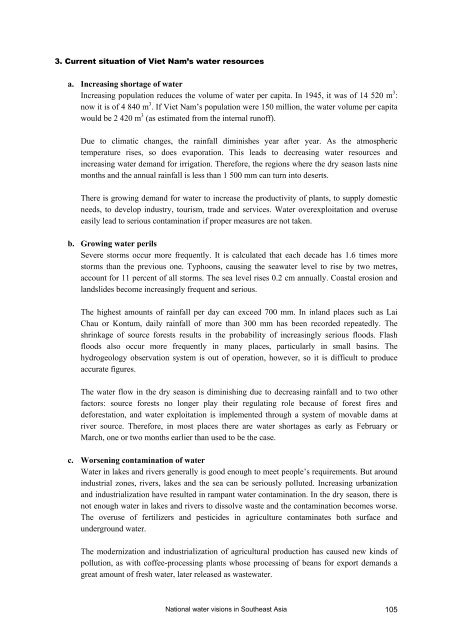The FAO-ESCAP pilot project on national water visions. From vision ...
The FAO-ESCAP pilot project on national water visions. From vision ...
The FAO-ESCAP pilot project on national water visions. From vision ...
Create successful ePaper yourself
Turn your PDF publications into a flip-book with our unique Google optimized e-Paper software.
3. Current situati<strong>on</strong> of Viet Nam’s <strong>water</strong> resources<br />
a. Increasing shortage of <strong>water</strong><br />
Increasing populati<strong>on</strong> reduces the volume of <strong>water</strong> per capita. In 1945, it was of 14 520 m 3 :<br />
now it is of 4 840 m 3 . If Viet Nam’s populati<strong>on</strong> were 150 milli<strong>on</strong>, the <strong>water</strong> volume per capita<br />
would be 2 420 m 3 (as estimated from the internal runoff).<br />
Due to climatic changes, the rainfall diminishes year after year. As the atmospheric<br />
temperature rises, so does evaporati<strong>on</strong>. This leads to decreasing <strong>water</strong> resources and<br />
increasing <strong>water</strong> demand for irrigati<strong>on</strong>. <str<strong>on</strong>g>The</str<strong>on</strong>g>refore, the regi<strong>on</strong>s where the dry seas<strong>on</strong> lasts nine<br />
m<strong>on</strong>ths and the annual rainfall is less than 1 500 mm can turn into deserts.<br />
<str<strong>on</strong>g>The</str<strong>on</strong>g>re is growing demand for <strong>water</strong> to increase the productivity of plants, to supply domestic<br />
needs, to develop industry, tourism, trade and services. Water overexploitati<strong>on</strong> and overuse<br />
easily lead to serious c<strong>on</strong>taminati<strong>on</strong> if proper measures are not taken.<br />
b. Growing <strong>water</strong> perils<br />
Severe storms occur more frequently. It is calculated that each decade has 1.6 times more<br />
storms than the previous <strong>on</strong>e. Typho<strong>on</strong>s, causing the sea<strong>water</strong> level to rise by two metres,<br />
account for 11 percent of all storms. <str<strong>on</strong>g>The</str<strong>on</strong>g> sea level rises 0.2 cm annually. Coastal erosi<strong>on</strong> and<br />
landslides become increasingly frequent and serious.<br />
<str<strong>on</strong>g>The</str<strong>on</strong>g> highest amounts of rainfall per day can exceed 700 mm. In inland places such as Lai<br />
Chau or K<strong>on</strong>tum, daily rainfall of more than 300 mm has been recorded repeatedly. <str<strong>on</strong>g>The</str<strong>on</strong>g><br />
shrinkage of source forests results in the probability of increasingly serious floods. Flash<br />
floods also occur more frequently in many places, particularly in small basins. <str<strong>on</strong>g>The</str<strong>on</strong>g><br />
hydrogeology observati<strong>on</strong> system is out of operati<strong>on</strong>, however, so it is difficult to produce<br />
accurate figures.<br />
<str<strong>on</strong>g>The</str<strong>on</strong>g> <strong>water</strong> flow in the dry seas<strong>on</strong> is diminishing due to decreasing rainfall and to two other<br />
factors: source forests no l<strong>on</strong>ger play their regulating role because of forest fires and<br />
deforestati<strong>on</strong>, and <strong>water</strong> exploitati<strong>on</strong> is implemented through a system of movable dams at<br />
river source. <str<strong>on</strong>g>The</str<strong>on</strong>g>refore, in most places there are <strong>water</strong> shortages as early as February or<br />
March, <strong>on</strong>e or two m<strong>on</strong>ths earlier than used to be the case.<br />
c. Worsening c<strong>on</strong>taminati<strong>on</strong> of <strong>water</strong><br />
Water in lakes and rivers generally is good enough to meet people’s requirements. But around<br />
industrial z<strong>on</strong>es, rivers, lakes and the sea can be seriously polluted. Increasing urbanizati<strong>on</strong><br />
and industrializati<strong>on</strong> have resulted in rampant <strong>water</strong> c<strong>on</strong>taminati<strong>on</strong>. In the dry seas<strong>on</strong>, there is<br />
not enough <strong>water</strong> in lakes and rivers to dissolve waste and the c<strong>on</strong>taminati<strong>on</strong> becomes worse.<br />
<str<strong>on</strong>g>The</str<strong>on</strong>g> overuse of fertilizers and pesticides in agriculture c<strong>on</strong>taminates both surface and<br />
underground <strong>water</strong>.<br />
<str<strong>on</strong>g>The</str<strong>on</strong>g> modernizati<strong>on</strong> and industrializati<strong>on</strong> of agricultural producti<strong>on</strong> has caused new kinds of<br />
polluti<strong>on</strong>, as with coffee-processing plants whose processing of beans for export demands a<br />
great amount of fresh <strong>water</strong>, later released as waste<strong>water</strong>.<br />
Nati<strong>on</strong>al <strong>water</strong> visi<strong>on</strong>s in Southeast Asia 105
















